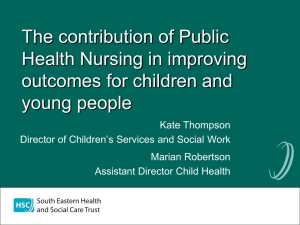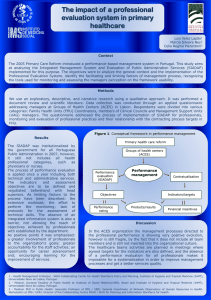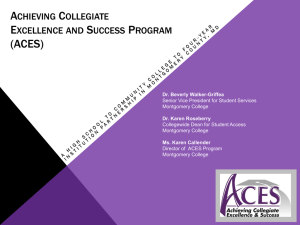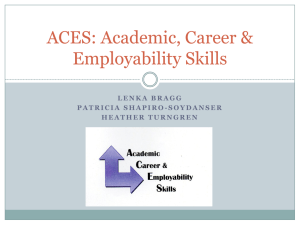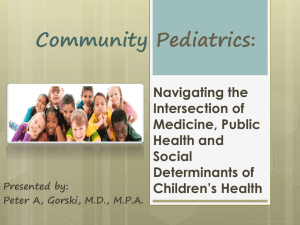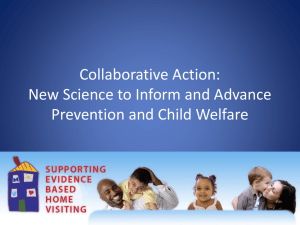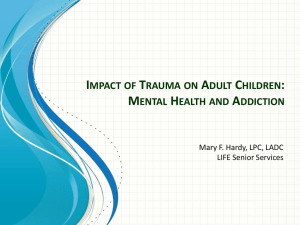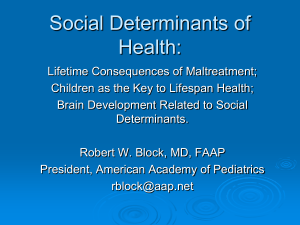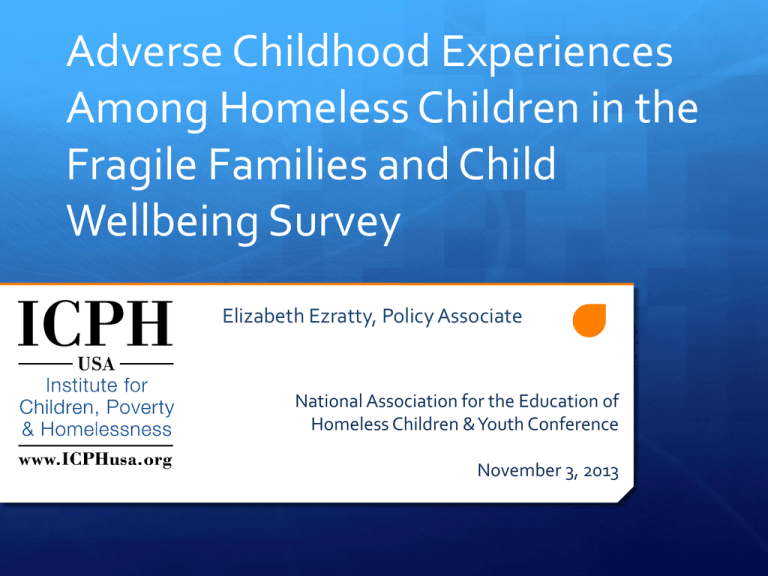
Adverse Childhood Experiences
Among Homeless Children in the
Fragile Families and Child
Wellbeing Survey
Elizabeth Ezratty, Policy Associate
National Association for the Education of
Homeless Children & Youth Conference
November 3, 2013
Learning Objectives
Understand the implications of adverse childhood
experiences (ACEs) on lifelong health, risk taking behaviors,
and mental wellbeing
Understand the prevalence of neglect, abuse, and family
dysfunction in homeless, at risk, and stably housed children’s
lives
Present policy initiatives that reduce adverse childhood
experience exposures and identify children most at risk of
childhood trauma
Presentation overview
Explain the Adverse Childhood Experiences Study and adverse
childhood experiences (ACE) framework
Ongoing ACE research through Behavioral Risk Factor Surveillance System
Introduce Fragile Families and Child Wellbeing Survey (Fragile Families)
and ICPH research approach
Present and explain the prevalence of ACEs among children in Fragile
Families
Present and explain the prevalence of ACEs among Fragile Families
after controlling for poverty
Discuss policies and approaches that buffer against ACEs
Stress & Child Development
The National Scientific Council on the Developing Child at Harvard University
distinguishes 3 types of stress:
Positive: experiences that are part of every day life and cause brief
and moderate physiological stress responses (immunizations, meeting
a new person).
Tolerable: non-normative experiences that are intense but bearable
due to the presence of a supportive adult (death of a loved one,
traumatic event or accident).
Toxic: intense, frequent, and uncontrollable experiences during which
a child lacks the support of a caring adult (child abuse or neglect). Can
result in an altered physiological response to stress and diminished
brain development.
Finding Your ACE Score
While you were growing up, during your first 18 years of life:
1. Did a parent or other adult in the household often or very often…
Swear at you, insult you, put you down, or humiliate you?
or
Act in a way that made you afraid tha t you might be physically hurt?
Yes No
If yes enter 1
______ __
2. Did a parent or other adult in the household often or very often…
Push, grab, slap, or thro w something at you?
or
Ever hit you so hard that you had marks or were injured?
Yes No
If yes enter 1
______ __
3. Did an adult or person at least 5 years older than you ever…
Touch or fondle you or have you touch their body in a sexual way?
or
Attempt or actually have oral, anal, or vaginal intercourse with you?
Yes No
If yes enter 1
______ __
4. Did you often or very often feel that …
No one in your family loved you or thought you were important or special?
or
Your family didn’t look out for each other, feel close to each other, or support each other?
Yes No
If yes enter 1 ______ __
5. Did you often or very often feel that …
You didn’t have enough to eat, had to wear dirty clothes, and had no one to protect you?
or
Your parents were too drunk or high to take care of you or take you to the doctor if you needed
it?
Yes No
If yes enter 1 ______ __
6. Were your parents ever separated or divorced?
Yes No
If yes enter 1
______ __
7. Was your mother or stepmother:
Often or very often pushed, grabbed, slapped, or had something thrown at her?
or
Sometimes, often, or very often kicked, bitten, hit with a fist, or hit with something hard?
or
Ever repeatedly hit at least a few minutes or threatened with a gun or knife?
Yes No
If yes enter 1 ______ __
8. Did you live with anyo ne who was a problem drinker or alcoholic or who used street drugs?
Yes No
If yes enter 1 ______ __
9. Was a household member depressed or mentally ill, or di d a household member attempt suicide?
Yes No
If yes enter 1 ______ __
10. Did a household member go to prison?
Yes No
If yes enter 1
Now add up your “Yes” answers: _______ This is your ACE Score.
092406RA4CR
______ _
Reproduced with permission
from: Robert F. Anda, and
Vincent J. Felitti, Centers for
Disease Control and Kaiser
Permanente.
http://acestudy.org/ace_scor
e
Adverse Childhood Experiences Study
Collaborative effort between the Centers for Disease Control and Kaiser
Permanente in San Diego
Retrospective study in the 1990’s involving more than 17,000 adults
Explored relationship between experiences through 18 years old and
adult health and wellbeing
Respondents could have a possible ACE score of between 0 and 10
representing the number of ACEs experienced through 18 years old.
54% of respondents were women, average age was 57, 74% were white,
36% attended some college, and 50% were college graduates
Adverse Childhood Experiences Study
Abuse:
Neglect:
• Sexual
• Physical
• Physical
• Emotional
• Emotional
Family Dysfunction:
• Presence of domestic violence
in home
• Separation, divorce, or loss of
a parent
• Household member with
depression or suicidal
tendencies
• Household member sent to
prison
• Household member with drug
or alcohol issues
Adverse Childhood Experiences Study
Findings
Incarcerated Relative
11%
Mental Illness
19%
Substance Use
28%
Domestic Violence
13%
Loss of a parent
23%
Physical Neglect
10%
Emotional Neglect
15%
Sexual Abuse
21%
Physical Abuse
28%
Emotional Abuse
11%
0%
10%
20%
30%
40%
50%
60%
70%
80%
90%
Source: Adverse Childhood Experiences Study and the Centers for Disease Control and Violence Prevention.
100%
Connection between ACEs and Health &
Behavior Outcomes
1= no additional risk
Source: Adverse Childhood Experiences Study and the Centers for Disease Control and Violence Prevention.
Life Expectancy of people with 0 & 6+ ACEs
0 ACEs
80 Years
60 Years
6+ ACEs
Source: Adverse Childhood Experiences Study and the Centers for Disease Control and Violence Prevention.
Presentation overview
Explain the Adverse Childhood Experiences Study and adverse childhood
experiences (ACE) framework
Ongoing ACE research through Behavioral Risk Factor Surveillance System
Introduce Fragile Families and Child Wellbeing Survey (Fragile Families) and
ICPH research approach
Present and explain the prevalence of ACEs among children in Fragile Families
Present and explain the prevalence of ACEs among Fragile Families after
controlling for poverty
Discuss policies and approaches that buffer against ACEs
The Behavioral Risk Factor Surveillance
System (BRFSS)
Largest health and behavior surveillance system in the
world
Implemented in all 50 states and territories through
State Departments of Health
ACE module has been implemented in 22 states thus far
Excludes questions on neglect
Prevalence of ACEs in 5 State BRFSS
Data from:
Arkansas
Louisiana
New Mexico
Tennessee
Washington
4+ ACEs
15%
3 ACEs
9%
0 ACEs
41%
2 ACEs
13%
1 ACE
22%
Source: Centers for Disease Control and Prevention, “Adverse Childhood Experiences Reported by Adults – Five
States, 2009,” Morbidity and Mortality Weekly Vol. 59, no. 49 (2010).
Risk of Health & Behavior Outcomes in
Minnesota BRFSS
1 = no additional risk
Source: Minnesota Department of Health, Adverse Childhood Experiences in Minnesota: Findings & Recommendations Based on the 2011
Minnesota Behavioral Risk Factor Surveillance System, January 2013.
Risk of Adult Health & Behavior
Outcomes in Washington BRFSS
1 = no additional risk
Source: Source: Anda and Brown, Adverse Childhood Experiences and Population Health in Washington: The Face of a Chronic Public Health
Disaster, Results from the 2009 Behavioral Risk Factor Surveillance System (BRFSS), July 2, 2010.
Presentation overview
Explain the Adverse Childhood Experiences Study and adverse childhood
experiences (ACE) framework
Ongoing ACE research through Behavioral Risk Factor Surveillance System
Introduce Fragile Families and Child Wellbeing Survey (Fragile Families) and
ICPH research approach
Present and explain the prevalence of ACEs among children in Fragile Families
Present and explain the prevalence of ACEs among Fragile Families after
controlling for poverty
Discuss policies and approaches that buffer against ACEs
Fragile Families and Child Wellbeing Survey
Background
Fragile Families Sample Cities
Birth cohort longitudinal dataset
Children born between 1998-2000
Five waves: birth, age 1, 3, 5 & 9
Data collected in 20 large (pop > 200,000)
U.S. cities
Nationally representative of births
between 1998-2000 in large U.S. urban
centers
Detailed variables at each wave
Demographics
Family composition
Labor market behavior
Fertility
Relationships
Health & well-being
Housing status
Parenting practices
Disciplinary approaches
Here’s what we did:
If any one of the questions that comprised an ACE indicator was
answered then a family was included
Likely under-represents ACEs
Surveys and in-home assessments analyzed for ACE indicators
based on the original ACE survey
ACE indicators constructed from multiple questions in each wave
Not every question is asked each year
Respondents are caregivers
Likely under-represents ACEs
A total of 2,410 families were included
Here’s what we did:
Questions cover the first 9 years of the subject child’s life
Questions were included if they inquired about the subject
child’s experiences of abuse or neglect, or the presence of
family dysfunction in the home
Used the BRFSS as guidance on how to define “often or very
often”
May under or over-represent ACEs
Frequencies used
Emotional Abuse:
“swore or cursed at” 3 or more times in the last year
“shouted, yelled, screamed, swore, or cursed” a few times a week
Called the child “dumb or lazy” or some other similar name 6 or more times in the
last year
Emotional Neglect:
“said you would send child away/kick out of the house” 6 or more times in past year
“you're caught up with own problems-not able to show love to child” 6 or more
times in past year
Physical Abuse:
hit the child “on the bottom with a belt” or similar object or hit the child “with a hard
object like a brush” on the bottom 3 or more times in the last year
slapped the child on the “leg, arm or hand” 11 or more times in the last year
Any questions related to spanking were excluded
Housing Status definitions
Ever homeless or doubled up includes families that lived in
shelters or other places not meant for human habitation or were
living doubled up with family or friends but not paying rent
Ever at risk includes families reported having troubles paying
essential bills such as rent or mortgage, phone, or utilities, that
they moved more than twice in the last year, or had ever been
evicted
Always stably housed includes families who reported none of
these issues
Fragile Families Demographics
Housing Status:
Mother’s Education at baseline
Ever Homeless/Doubled up: 27%
<HS:
28%
At Risk of homelessness:
40%
HS/GED:
31%
Always stably housed:
33%
Some College/Technical School:
19%
College/Graduate School:
22%
Mother’s Race/Ethnicity:
Black:
24%
Mother’s Relationship at Baseline:
White:
35%
Single:
20%
Hispanic:
33%
Cohabitated:
21%
Other:
9%
Married:
59%
Mom’s Mean Age at birth of focal child (baseline):
27 years old
Presentation overview
Explain the Adverse Childhood Experiences Study and adverse childhood
experiences (ACE) framework
Ongoing ACE research through Behavioral Risk Factor Surveillance System
Introduce Fragile Families and Child Wellbeing Survey (Fragile Families) and
ICPH research approach
Present and explain the prevalence of ACEs among children in Fragile Families
Present and explain the prevalence of ACEs among Fragile Families after
controlling for poverty
Discuss policies and approaches that buffer against ACEs
Cumulative Number of ACEs in Fragile
Families
6+ ACEs
5 ACEs
3%
7%
0 ACEs
10%
0 ACEs
11%
4 ACEs
1 ACE
23%
1 ACE
2 ACEs
3 ACEs
4 ACEs
18%
5 ACEs
3 ACEs
6+ ACEs
2 ACEs
28%
Individual ACE-indicators in Fragile
Families
Prison
18%
Mental Illness
56%
Substance use
15%
Domestic Violence
10%
Loss of a parent
*
*
29%
Physical Neglect 3%
Emotional Neglect
*
6%
Sexual Abuse 1%
Physical Abuse
30%
Emotional Abuse
60%
0%
10%
20%
30%
* Constructed from fewer questions in Fragile Families
40%
50%
60%
70%
80%
90%
100%*
Number of Cumulative ACEs by
Housing Status
40%
36%
34%
35%
Percentage of Children
30%
27%
25%
22%
18%
20%
15%
15%
10%
Homeless
(n=861)
25%
20%
17%
16%
14%
10%
9%
6%
16%
10%
3%
5%
1%
0%
0 ACEs
1 ACEs
2 ACEs
3 ACEs
Number of Cumulative ACEs
4 ACEs
5+ ACEs
At Risk
(n=1065)
Stably
Housed
(n=484)
Presence of Child Maltreatment by
Housing Status
70%
Percentage of Children
60%
63%
60%
57%
Homeless
(n=861)
50%
38%
34%
40%
At Risk
(n=1065)
30%
17%
20%
10%
2% 2% 0%
0%
Emotional
Abuse
Physical Abuse
Sexual Abuse
5%
8%
4%
Emotional
Neglect
Type of Child Maltreatment
4% 3%
Stably
Housed
(n=484)
1%
Physical Neglect
Presence of Household Dysfunction by
Housing Status
80%
72%
70%
58%
Percentage of Children
60%
Homeless
(n=861)
50%
41%
40%
35%
34%
29%
30%
20%
24%
18%
10%
At Risk
(n=1065)
22%
15%
14%
11%
5%
8%
4%
0%
Loss of a parent
Domestic
Drug, Alcohol Mental Illness
Violence
Use
Type of Family Dysfunction
Prison
Stably
Housed
(n=484)
Inter-relatedness of childhood traumas
Emotional
Abuse
Emotional
Neglect
Living with a
Substance
Abuser
• 3x odds of
physical
abuse
• 2x odds of
emotional
abuse
• 2.4x odds of
physical neglect
• 2x odds of
emotional
neglect
• Nearly 2x
odds of
physical
abuse
• 1.4x odds of a
household
member
suffering from
mental illness
• Almost 5.5x
odds of
physical
neglect
• 2.4x odds of
living with
domestic
violence
Living with
Domestic
Violence
• Slightly higher
odds of
emotional and
physical abuse
• 2.4x odds of
living with a
substance abuser
• 2.5x odds of a
household
member
reporting mental
illness
Summary
ACEs are common for children in Fragile Families
Housing status is associated with differential levels of ACEs
ACEs are inter-related
Presentation overview
Explain the Adverse Childhood Experiences Study and adverse childhood
experiences (ACE) framework
Ongoing ACE research through Behavioral Risk Factor Surveillance System
Introduce Fragile Families and Child Wellbeing Survey (Fragile Families) and
ICPH research approach
Present and explain the prevalence of ACEs among children in Fragile Families
Present and explain the prevalence of ACEs among Fragile Families after
controlling for poverty
Discuss policies and approaches that buffer against ACEs
Poverty and ACEs in Fragile Families
Split group into Poor (below 130% of federal poverty line) and
Not Poor (above 130% of FPL)
$24,817 for a family of 3 in 2012-2013
Ensures that comparisons between groups reflect differences
in housing status rather than poverty
Total number of families in Poor subsample is 1,103
Homelessness among Poor and Not Poor
Children
60%
48%
Percentage of Children
50%
40%
44%
37%
35%
30%
Poor
21%
Not Poor
20%
15%
10%
0%
Homeless/ DU
At Risk
Housing Status
Stably Housed
Number of ACEs among Poor and Not
Poor Children
35%
29%
Percentage of Children
30%
24%
25%
21%
20%
15%
25%
Poor
(n=1103)
20%
17%
15%
13%
9%
10%
6%
Not Poor
(n=1307)
9%
6%
5%
5%
1%
0%
0 ACEs
1 ACE
2 ACEs
3 ACEs
4 ACEs
Number of ACEs
5 ACEs
6+ ACEs
Individual ACEs among Poor Children in
Fragile Families
Prison
31%
Mental Illness
63%
Substance use
22%
Domestic Violence
16%
Loss of a parent
*
Physical Neglect
* Emotional Neglect
*
32%
5%
7%
Sexual Abuse 1%
Physical Abuse
29%
Emotional Abuse
55%
0%
10%
20%
30%
* Constructed from fewer questions in Fragile Families
40%
50%
60%
70%
80%
90%
100%
Number of Cumulative ACEs by Housing Status
among Poor Children
60%
56%
50%
Homeless
(n=510)
40%
At Risk
(n=484)
31%
30%
22%
20%
10%
16%
12%
17%
22%
20%
14%
8%
5%6%
21%
13%
12%
9%
6%6%
4%
0%
0%
0 ACEs
1 ACEs
2 ACEs
3 ACEs
4 ACEs
Stably
Housed
(n=109)
5 Aces
0%
6+ Aces
Presence of Maltreatment among Poor
Children
70%
61%
Percentage of Children
60%
50%
54%
Homeless
(n=510)
44%
40%
At Risk
(n=484)
33%31%
30%
Stably
Housed
(n=109)
20%
12%
7%
10%
2%
0%
Emotional
Abuse
Physical Abuse
0% 0%
Sexual Abuse
10%
6% 5% 4%
0%
Emotional
Type of Maltreatment Neglect
Physical Neglect
Presence of Household Dysfunction by Housing
Status among Poor Children
80%
76%
70%
59%
Percentage of Children
60%
50%
44%
43%
Homeless
(n=510)
41%
40%
30%
20%
30%
30%
At Risk
(n=484)
24%
17%
20%
19%
16%
11%
10%
10%
5%
0%
Loss of a parent
Domestic
Violence
Substance Use
Mental Illness
Household Dysfunction Indicator
Prison
Stably
Housed
(n=109)
Limitations
Fragile Families questions were not the same as ACE survey
ACE indicators constructed from multiple questions
Not all ACE indicators were asked in every year
Original ACE survey questions ask if maltreatment occurred
“often” or “very often”
Most Fragile Families questions are directed to a caregiver
rather than the child
Summary
Poor children experience more ACEs than those who are Not
Poor
Poor homeless and doubled up children experience more
cumulative ACEs than other housing groups
Differential rates of household dysfunction, abuse, and
neglect exist between housing categories
Questions cover the first 9 years of life
Results are conservative
Presentation overview
Explain the Adverse Childhood Experiences Study and adverse childhood
experiences (ACE) framework
Ongoing ACE research through Behavioral Risk Factor Surveillance System
Introduce Fragile Families and Child Wellbeing Survey (Fragile Families) and
ICPH research approach
Present and explain the prevalence of ACEs among children in Fragile Families
Present and explain the prevalence of ACEs among Fragile Families after
controlling for poverty
Discuss policies and approaches that buffer against ACEs
Prevention Approaches
Parental Engagement
Home Visiting programs
Early Childhood Education
School Based Health Centers
Parental Engagement
Home Visiting Programs
Send qualified professionals to visit expecting parents or
parents with children up to age five
This professional could be a nurse, a social worker, a
counselor, or a culturally competent peer community
member
Teach skills that promote positive child-parent relationships
and improved child and maternal health and wellbeing
Home Visiting Evidence
Home Visiting programs impact:
Increased birth spacing
Child health
Parental self-sufficiency
Reduced incidence of abuse and neglect reports
Improved positive parenting techniques
Source: Olds et. al, “Long-term effects of home visitation on maternal life course and child abuse and neglect.
Fifteen-year follow-up of a randomized trial,” JAMA (1997); Duggan et. al., “Evaluation of Hawaii’s Healthy Start
program,” Future of Children, (1999); U.S. DHHS, Home Visiting Evidence of Effectiveness; New York State Office of
Children and Family Services, Bureau of Evaluation and Research, Healthy Families New York: Reflections, 2011.
Barriers for homeless families & providers
Home visitors struggled with family transience and programs often
operate using geographic zones
Staff possessed limited knowledge of the homeless system
Staff were not adequately trained to deal with families in crisis
Strict program guidelines leave little or no option to conduct
meetings in public spaces
Low levels of parent engagement
Privacy issues with families who double up
Source: Carie Bires, Heartland Alliance, FACT Project, Heartland Health Outreach, Partnering to Serve Homeless
Children, Presented at the National Alliance to End Homelessness Conference, February 2013.
Parental Engagement
Early Childhood Education
Parent engagement or positive experiences in high quality
early childhood education can moderate many negative child
behavior and cognitive outcomes from:
Domestic violence
Having a household member in prison
Maternal depression
Substance use
Source: Administration for Children and Families, US DHHS, Head Start FACES 2000:
A Whole-Child Perspective on Program Performance, Fourth Progress Report, (2003).
Barriers for homeless families
Waiting lists
Family transience
Cost
Poor outreach and awareness
Transportation difficulties
Time
Barriers for service providers
Lack of trust of and fatigue with social services
Child absenteeism
Parent involvement
Evaluation compliance
Parent Engagement Promising Initiatives
Washington
authorized parent participation in voluntary home visiting programs, Head Start
or other parent child development activities, or volunteering at their child’s day
care, pre-school, or school to count as part of a parent’s TANF mandatory
work requirements
Massachusetts
parenting workshops fulfill the activity requirement to receive a subsidy under
the Child Care and Development Fund
Maryland
Since 2002, all four year olds living at or below 185 percent of the federal
poverty threshold are entitled to early learning services
Montgomery County created “parent academies” for all student families
Oklahoma
Since 1998, every 4-year-old in Oklahoma gets free access to a year of highquality pre-k.
School Based Health Centers
School based health centers:
Improve access to medical care
Improve access to mental health counseling
increased use of hormonal birth control
Increased use of mental health services
Source: Soleimanpour et.al., “The Role of School Health Centers in Health Care Access and Client Outcomes,”
American Journal of Public Health, (2010); Ethier et.al., “School-based health center access, reproductive health care,
and contraceptive use among sexually experienced high school students,” Journal of Adolescent Health, (2011).
School based health centers & trauma
The inter-connectedness of childhood traumas should act as
a blue print for screening of other ACEs.
Under the Affordable Care Act, health plans will have to
provide behavioral health screenings for children for free.
Counseling may help children cope with the stress associated
with housing instability
Forum to identify and prevent other childhood traumas for
which homeless and doubled up children have greater risk
Source: The White House Blog, “The Affordable Care Act and Expanding Mental Health Coverage,” August 21, 2013.
Summary
Adverse Childhood Experiences have real long term
consequences
Poor children experience more ACEs than non poor children
Homeless and double up children report the most ACEs
Home visiting programs and early childhood education
programs with parental engagement lower risk of or mediate
effects ACEs
School Based Health Centers are logical venues to help
identify and treat ACEs
Learning Objectives
Understand the implications of adverse childhood
experiences (ACEs) on lifelong health, risk taking behaviors,
and mental wellbeing
Understand the prevalence of neglect, abuse, and family
dysfunction in homeless, at risk, and stably housed children’s
lives
Present policy initiatives that reduce adverse childhood
experience exposures and identify children most at risk of
childhood trauma
Discussion questions
What steps can you take to help educate others about the
long term effects of ACEs?
Are there any programs or initiatives in your communities
that address ACEs?
How does the research presented here compare to what you
see in your community?
Does the research presented on childhood trauma help you
to look at children in your classrooms or schools differently?
Elizabeth Ezratty
eezratty@icphusa.org
Thank you

